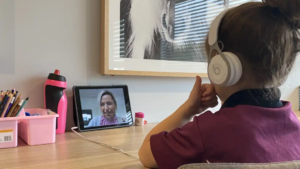Home » Commentary » Opinion » Learning from home isn’t fair or sustainable
· Financial Review
 If the best that can be said for digital education is that it’s useful for some months during an unprecedented pandemic, then there probably isn’t much to be said for it normally.
If the best that can be said for digital education is that it’s useful for some months during an unprecedented pandemic, then there probably isn’t much to be said for it normally.
While it’s generally good to look on the bright side, it would be incredibly naïve to think the current situation for Australian schools presents more opportunities than threats.
The research on the efficacy of education technology is inconsistent.
Even in normal times, it is not clear that tech helps students to learn – and these are not normal times. It may benefit some highly motivated learners, but others will be worse off.
Making the transition for millions of Australian students to digital learning is arguably necessary as a temporary, emergency measure. But there is no strong evidence it is more effective than face-to-face classes.
And the harsh truth is that there is a huge amount of inconsistency in how our school system is implementing remote learning, and students from disadvantaged social backgrounds are most negatively affected.
Most children are learning from home, while schools remain notionally open with some students attending.
Learning from home can be anything from sophisticated online classes following a normal school day timetable to basic homeschooling with haphazard resources.
The patchiness of remote education is a key reason that schools should go back to normal as soon as it is safe and possible.
In the meantime, families from disadvantaged backgrounds are disproportionately affected.
Students who have access to parental help and effective online learning with fast internet speeds will learn much more than students who don’t. And students falling behind in core subjects is a particular concern in the primary school years.
Effective early literacy and numeracy instruction is vital. It provides the foundations for later learning, across subject areas.
If primary students are missing out on several months of learning in these key areas, it could take years for them to catch up to their peers.
Aside from long-term education outcomes, another sad irony here is that children from disadvantaged backgrounds who are most in need of the positive face-to-face social interaction at school are unable to receive it at a stressful time when it would be particularly beneficial.
And don’t forget the impact on parents. While people who can easily work from home – such as corporate office workers – are facing difficulties supervising their children’s at-home education, it is much harder for many other workers – such as tradies – who cannot stay home without risking their income.
A silver lining may be that parents become more involved in their children’s schooling (despite the almost insurmountable challenges of doing so while also trying to participate in online work meetings).
Parents will benefit from becoming more aware of what their children are being taught, and also gain first-hand knowledge of some of the flaws in the curriculum, such as the focus on fluffy “general capabilities” rather than actual content knowledge.
No one envies the policymakers navigating the policy on schools at the time of the coronavirus, seemingly having to thread the needle between saving lives and continuing children’s education.
There are no good options right now.
But the federal and state education ministers must realise that a permanent shift to remote education is not an option.
It’s not sustainable or fair to deny students months of normal learning progress.
The clock is ticking, and schools should reopen for all students as soon as it is safe and possible.
Learning from home isn’t fair or sustainable